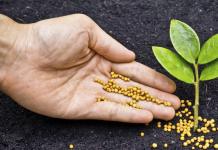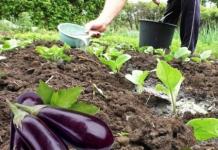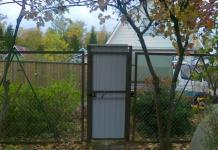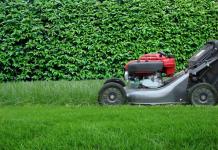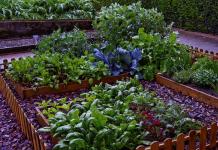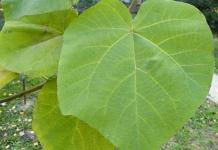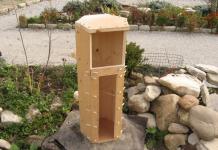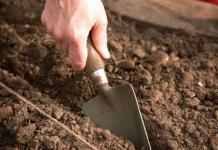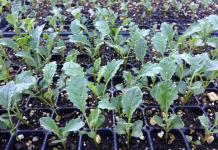Spinach is a herbaceous vegetable plant, popular and loved all over the world. The French, for example, consider this culture of ancient origin to be the king of vegetables. How to grow spinach in a country house of good quality - this question interests many summer residents.
The peculiarity of green culture
Spinach is a basal rosette of glossy leaves. This is a diverse plant. There are male and female representatives of the vegetable. In male specimens, small and few leaflets appear from the sinuses. They are removed during thinning. Large, juicy leaves for cutting give females, they are left in the beds. Female specimens form nut-seeds.
Spinach roots are weak, grow 20 cm deep, which complicates the process of growing and care.
Another culture is called a plant of a long day. When the day increases, flower stalks appear, the leaves lose their juiciness, which is associated with an increase in the level of oxalic acid.
Qualitative characteristics of vegetable crops
Spinach has excellent qualities for growing in the garden, including:
- The plant is not afraid of cold weather. Seeds begin to germinate at a temperature of 4 degrees, the shoots that have appeared are able to withstand short-term spring frosts.
- Early maturity and high yield. The vegetation period of the plant lasts 1 month. You can plant it in your summer cottage during the season several times every 2 weeks. But the best time to harvest is spring. The leaves are more juicy and fleshy in spring.
Varietal diversity of culture
Before you start growing spinach from seeds, you need to choose the right plant variety.
When choosing a variety, pay attention to the ripening time of the crop, which is indicated on the label of the bag with seeds. Having picked up seeds of different types, you can organize a conveyor collection on your site.  All varieties and hybrids are divided into early, medium ripening and late.
All varieties and hybrids are divided into early, medium ripening and late.
- early varieties. 15 days after germination, you can already cut the leaves. If you sow late, the culture will shoot early. The early ripe ones include Matador, Gigantic, Khorovod.
Please note that each of them has additional qualities:- The matador is resistant to low temperature and color. By the way, this is one of the most high-yielding and popular varieties. You can learn more about it on the Internet pages, as well as order seeds. You will need to enter in the search "spinach matador growing from seeds"
- Gigantic can be grown both in open ground and in protected. It does not throw arrows for a long time, it is resistant to the accumulation of nitrates.
- Khorovod has a high content of vitamins.
- Medium varieties - such as Rembrandt, Emerald F1 - ripen 20 days after germination.
- Late ripe. Ready for harvest in 25 days. Victoria, Varyag, Ladya. They are resistant to shooting, they can be sown in the summer.
- For growing at home on the windowsill, take late-ripening varieties such as Victoria, Virtuoso or Melody, Prima hybrids.
It is worth adding that the constant selection work on the development of new varieties of spinach, low-shooting early, resistant to powdery mildew, giving a large mass of greenery, does not stop. New items appear every year.  Undoubtedly, the early ripe variety of strawberry spinach and its cultivation from seeds will arouse the interest of summer residents. It gives, in addition to juicy leaves, fruits that have a strawberry flavor. The fruits are suitable for both food and processing.
Undoubtedly, the early ripe variety of strawberry spinach and its cultivation from seeds will arouse the interest of summer residents. It gives, in addition to juicy leaves, fruits that have a strawberry flavor. The fruits are suitable for both food and processing.
Strawberry spinach is an annual plant up to 50 cm high. Fruit ovaries appear in the axils of the plant. On the fourth day after the formation of the ovaries, the fruits ripen and are ready to eat. Moreover, growing strawberry spinach is not particularly difficult.
Selecting a landing site
High-quality cultivation of spinach in the open field largely depends on the correct choice of a place for planting the crop. Consider the recommendations of experts:
- Loamy and sandy soils are best suited. If you have clayey, heavy soils, you should think carefully before planting a crop: you will have to spend a lot of time and effort on planting and care, and the result will be unsatisfactory. The acidity of the soil should be neutral.
- Greenery grows well in well-lit, open and elevated areas. In regions with too hot summers, you can choose partial shade for planting.
- It is advisable to plant the plant in places protected from the cold north or east wind, as the culture does not like drafts.
- Consider crop rotation rules when choosing a site: potatoes, radishes, legumes, cucumbers, zucchini, and tomatoes are considered the best predecessors of spinach.
- You should not plant a crop for more than 3 years in one place.
- Flowers will be bad neighbors for the plant, green crops will be good.
Features of soil preparation for sowing greens
 Spinach loves loose and nutritious soils, saturated with organic and mineral fertilizers, moisture and breathable, well-drained. Start preparing a garden bed for greens should be in the fall. Follow this sequence:
Spinach loves loose and nutritious soils, saturated with organic and mineral fertilizers, moisture and breathable, well-drained. Start preparing a garden bed for greens should be in the fall. Follow this sequence:
- Dig over the intended area.
- Apply organic matter (up to 8 kilograms per square meter), complex mineral fertilizer or superphosphate according to the instructions.
- Before the snow melts, add urea.
- Cultivate the soil in early spring.
- Add a bucket of humus per square meter of soil (if it didn’t work out in the fall) and a glass of ash.
Keep in mind that nitrates accumulate quickly in the leaves of the plant, so nitrogen fertilizers are not recommended in spring and, in general, nitrogen fertilizers should be applied carefully.
Culture methods
Spinach seeds can be sown both in open ground and for seedlings in protected ground.
The method of growing through seedlings is not particularly popular. The roots of seedlings of green culture are weak, when transplanted to a garden bed, they are injured, they do not take root well. It is optimally applied to heat-loving varieties of spinach (Matador, New Zealand).
Seed preparation
Spinach seeds have a dense shell. If you plant them dry, then seedlings will have to wait a long time.
To accelerate the emergence of seedlings, as well as to disinfect the seed, it is necessary to perform a set of measures:
- Sort through the material, discard small, dry nuts.
- During the day, they should be soaked in water at room temperature, changing it from time to time.
- Then, if necessary (if the material is your own, and was not purchased at a specialized store), the seeds are disinfected in a 1% solution of potassium permanganate.
- Dry slightly seed material, prepare for planting.
 Some plant varieties (Victoria, Corenta) have very poor germination, the soaking time for them is extended to two days, and biostimulants are added to the water.
Some plant varieties (Victoria, Corenta) have very poor germination, the soaking time for them is extended to two days, and biostimulants are added to the water.
How to sow a crop?
You can sow spinach in open ground in August, early in spring, in April, before winter. At a temperature of 5 degrees, landing can begin. When sowing, follow the instructions:
- Make tape-type grooves in 2-5 lines. The distance between the lines is 20 cm, the row spacing is 40-50 cm. The depth of seeding on loamy soils is 2-2.5 cm, sandy loam soils - up to 4 cm. Between seeds in a row 5-8 cm. Count on 1 square meter of the site to sow 3 g seeds.
- Slightly press the crops, pour water.
- It is advisable to cover the bed with a film to protect against possible night frosts and accelerate the emergence of seedlings.
- In a week and a half after sowing, shoots will appear.
The specifics of growing greenery in a greenhouse and at home
Spinach can also be grown in protected conditions - on a balcony, in a loggia, on a windowsill, in a greenhouse.
Growing spinach in a greenhouse can be started in autumn and continued until summer, sowing the seeds several times. Pay attention to the details:
- In practice, greens are grown as a compactor in the aisles of vegetable crops (cucumbers, tomatoes, peppers).
- In protected ground (in a greenhouse), lines on the beds are made every 10 cm, while the seeds are respectively consumed twice as much per square meter - 6g.
For home planting, you can take an ordinary flower pot (at least 1 liter of volume) or a plastic container. Be sure to make holes in the bottom to drain excess moisture and breathe the roots, put drainage.  The containers are filled with prepared soil by 10-15 cm.
The containers are filled with prepared soil by 10-15 cm.
The composition of the soil mixture:
- Humus-2 parts;
- Sod land - 2 parts;
- River clean and sifted sand - 1 part.
Another soil option is possible:
- Biohumus - 1 part;
- Coconut fiber - 2 parts.
Sowing is done starting from the third decade of January (due to lighting).
After sowing, in a month you will be able to harvest the first crop.
Growing and caring for spinach in the greenhouse and at home is the same as in the open field.
It is important to create an appropriate temperature of 15-18 degrees and sufficient lighting. The quality of planted spinach at temperatures above 20 degrees deteriorates: bolting begins, flowering, leaves become rough. 
Green crop care technology
Seedling care consists of watering, mulching, weeding, loosening, thinning, protection from pests.
- Plants love watering. Only with good watering will you get fleshy, large leaves. In the absence of rain, it is necessary to water, spending a bucket of water per square meter.
In dry, hot weather, it is recommended to water up to 3 times a week. - Growing and caring for spinach in the open field or in a greenhouse does not allow waterlogging: the culture can be affected by root rot.
- Mulching is done with grass, straw to retain moisture in the soil.
- Weeding is carried out for the first time after the growth of the first true leaf. The beds should be freed from weeds regularly, not only in order to improve the life of the plant, but also to protect against caterpillars and aphids.
- Loosening is performed shallow, to eliminate the crust and access oxygen to the roots.
- Thinning is carried out simultaneously with the first weeding - in the phase of the appearance of the first leaf. A distance of 10 cm is left between individual sprouts. With a denser planting, there is a risk of developing root rot or powdery mildew.
- Disease control. The most common green disease is root rot. Upon detection, the diseased plant should be uprooted, and the planting should be treated with 1% Bordeaux mixture. From pests, crops are treated with infusion of tobacco dust or ready-made biological products.
Harvesting vegetable plant
It is recommended to harvest spinach in the morning, before cooking. Large leaves are collected from young plants that do not have flower stalks. Pay attention to the specifics of the collection: 
- The leaves are broken off one by one.
- Rosettes are cut under the first leaf so that less dirt gets on the greens, and so that the planted plant can continue to grow further.
- The cut is made when the leaves reach a length of 18 cm.
- The number of leaves on a mature and ready-to-cut plant should be at least 6.
- Harvesting in the garden should be done regularly, as spinach quickly overripes.
- When arrows of flower stalks begin to appear, the plant is removed from the garden.
- The seeds of the plant ripen after 3 months. In the ripening phase, it is necessary to cut off the browned inflorescences, put in a shaded place for ripening.
- The germination of seeds that have been properly stored in a dry and cool place lasts 4 years.
For your information, seeds are collected only if one variety grows on the site, since spinach is a wind-pollinated crop. It is enough to leave 2 female plants on the beds with a distance of 20 cm between them to get a good seed crop.
Such a low-calorie, vitamin-rich product like spinach is ideal for dietary nutrition. The use of spinach improves immunity, relieves overwork, is recommended for diabetes, childhood rickets (high content of vitamin D).
The desire to diversify the garden with a variety of cultures is not always successful. But as for greenery, here the aspirations are rarely limited to the complexity of growing or the need to create special conditions. Therefore, for sure, what is worth starting in the beds is spinach, sowing and caring for which is not at all laborious.
In addition to being an extremely tasty, healthy, nutritious, but low-calorie leafy vegetable, it is also completely unpretentious. It is easy to find a place for spinach rows in any, even the smallest plot, and its aesthetic and compact appearance allows you to grow bushes even in a flower bed, where, in addition to being useful, it will also play a decorative role of green culture.

Spinach is quite resistant to cold, so it does not require a shelter
Therefore, if you decide to start growing spinach in the country, you should take advantage of its advantages:
- precocity allows you to plant it in areas prepared for the subsequent planting of seedlings of heat-loving vegetables - tomatoes, peppers or eggplants;
- spinach is quite resistant to cold, so it does not require a shelter device;
- seedling cultivation allows one of the first to get juicy spring greens;
- excellent compatibility with all the most common crops on the site (except beets), allows you to use it when arranging mixed beds or as a thickener for a while until the main crops grow.
Now that we have decided that there will always be a place for spinach, it is worth getting acquainted in more detail with the main preferences in the type of soil, the degree of moisture, the duration of illumination and the optimal temperature for development.
Video about the benefits of spinach
Planting spinach is more effective in the most lit places, this should be especially remembered when sowing in spring and autumn, when daylight hours are short. Humidity is also very important, as insufficient watering provokes bolting of plants, thereby worsening the taste of spinach and reducing the yield of its succulent leaves. And at the expense of fertilizers - even if the land under the garden is initially acceptable structure, it is still worth improving its fertility. To do this, it is enough to add half a bucket of organic matter per 1 sq.m and in the recommended dosage of complex mineral fertilizers.

Planting spinach is more effective in the most lit places
Now about the soil: in most cases, ordinary garden soil is fertile, loose, moist enough, perfect for growing. The only exceptions are acidic or too heavy, clayey soils with constant standing water. Under such conditions, most crops cannot develop successfully, including spinach, so if it is not possible to select another site, the existing “problem” soil should be improved.
First, about the indicators of acidity. You can determine its level without special devices, just look at what weeds grow around: bindweed and burdock - 6-7 pH and above; nettle, euphorbia and shepherd's purse - 5.5-6 pH; plantain, dandelion or wheat grass - 5-5.5 pH, but horsetail, moss or buttercup speak of high acidity - 4.5 pH and below. For spinach, the optimal indicator will be about 6.0-7.0 pH, so if the soil is not too suitable, you should add fluffy lime when digging at a dosage of 1 sq.m - 200g, with an initial indicator of about 5 pH, and 600-750g if the level is below 4 pH.
But with regard to high humidity and stagnant water, this problem can be solved by drainage. Depending on the degree of “clayness” of the soil, 2-3 buckets of coarse sand should be added per 1 sq.m. After digging and thoroughly mixing the resulting soil mixture, you can evaluate the degree of its improvement - whether it has become loose or you can add more sand. Heavy soil in particular needs liming and obligatory enrichment with organic fertilizers, whether it be mullein, rotted manure, bird droppings, or just a generous application of humus.

Heavy soils in particular need liming and obligatory enrichment with organic fertilizers.
Now, knowing where spinach will grow best, you can go directly to crops and plantings.
Regardless of where and how you grow spinach, it is recommended that you follow accepted sowing and seeding rates. Therefore, when sowing between rows, in a garden bed, in a greenhouse or open ground, it is important not to bury the seeds by more than 2-2.5 cm and leave 20-35 cm between rows.
It is imperative to sow in moist soil, if it seems to you that the earth is dry, you should first shed the grooves generously. After waiting for the water to be absorbed, you can start sowing.

Must be sown in moist soil
With the advent of seedlings, traditional planting care begins - regular weeding and timely watering. In addition, the quality of spinach often depends on the density of crops, so you need to control the thickening. The first time you can break through the spinach already in the phase of 2-3 leaves, while the torn rosettes should not be thrown away, and if they are immediately transplanted to another bed, they will continue to grow quite successfully. After thinning and transplanting, the plants must be thoroughly watered so that the disturbed roots can again adhere tightly to the soil.
Given the precocity of spinach, it does not require additional dressings. But if you doubt that the soil is fertile enough, you can add organic fertilizers in liquid form when irrigating the water. You can prepare such nutrient solutions on your own and almost free of charge, given that you can find everything you need in your country house, on the street or with your neighbors.
During fermentation, the solution in the container is recommended to be stirred periodically for speedy maturation. And during top dressing, it is important to remember that their excess is sometimes much more dangerous than a lack, so proceed with caution, especially when using bird droppings.
Here, perhaps, are all the tricks and all the care, pests and diseases almost never damage spinach, due to its precocity.
Keeping in mind the cold resistance of spinach, its first crops in the country can begin as soon as the snow melts, because already at a temperature of +4 ° C, the seeds can germinate quite successfully.
Advice! Growing spinach is similar in terms of requirements and care to growing, so often these crops are sown at the same time and in the same place.

Under favorable conditions, the first salad of young leaves can be made after 30-40 days from emergence
Depending on the climatic features of a particular region, spinach is planted from mid-April to mid-May. But given the high need for spinach in moisture, later plantings in dry land may not bring the expected results, and this crop does not like heat. Therefore, in this situation, the principle applies: the earlier the sowing, the better the harvest. Under favorable conditions, the first salad of young leaves can be made after 30-40 days from emergence. And if you want to get greens even earlier, then you can use the seedling method and first grow rosettes on the windowsill, like a radish, and then transfer them to the beds together with a clod of earth.
To avoid worries with seedlings, but to please with an early harvest, another way will help. Since the fall, completing the last garden work in the country, sow spinach seeds in a greenhouse or just in the garden - their spring shoots will be one of the earliest. If there is no stationary greenhouse, then when planting in open ground, it is recommended to cover the rows with a film or agrofiber so that in the spring the earth warms up faster, but does not lose moisture, and the growing greenery is clean.
Video about growing spinach
Crops in September will sprout already this year, they will endure wintering without any losses and in the spring, having thawed, they will continue to grow. If sown in October, then green rosettes can be seen in the first half of April after the snow melts.
And in order for tender spinach leaves to be on your table from the earliest spring to late autumn, you should choose the right varieties and periodically sow the seeds.
–garden crop containing many easily digestible vitamins, organic and fatty acids, micro and macro elements necessary for a healthy diet. These greens are useful and desirable on every table. Regular consumption of spinach is an excellent prevention of diseases of the digestive, nervous, cardiac systems, metabolic disorders, improves immunity well.
Did you know?Spinach leaves contain vitamins K, E, PP, C, P, A, B2, B6, manganese, silicon, iron, cobalt, thallium, boron, chromium, iodine, calcium, rubidium, zinc, vanadium. As well as serotonin, phytosterols, polysaccharides, omega-3 polyunsaturated fatty acids, ascorbic and oxalic acids.
When to sow spinach
Growing spinach in the open field can be started from the beginning or middle of April, focusing on the settled weather. Spinach is cold hardy, the air temperature of +4-5 °С is quite suitable for sowing, and its seedlings can withstand frosts down to -5-6 °С.
How to Get an Early Spinach Harvest

Spring planting of spinach gives a later harvest - around mid-June, not earlier. Is it possible and when exactly to plant spinach in open ground for earlier harvest? Can. This is done in regions with mild winters or winter varieties are sown in late August - early September.
Planting spinach before winter, they get the first greens already in April. With this method, during the time from sowing to the first shoots - in 14-16 days, spinach takes root and overwinters well. And with warming in March, it quickly goes up.
Important!After harvesting an early harvest, after 45-50 days, you can collect the greens from the bushes again for the second time, and the plants are completely removed.
Soil requirements for spinach
Neutral, loamy and sandy loamy soils rich in organic matter are best suited for growing spinach. In addition, the soil for spinach should not be overly acidic - pH no higher than 7.
Potatoes, cucumbers, legumes, white cabbage, tomatoes will be good predecessors for this plant.
Did you know?Food processing of spinach - cooking, frying, stewing, canning, freezing - slightly change its composition, it retains its useful biologically active elements.
Soil preparation for planting
 The soil for spinach is prepared in the fall - they fertilize and dig up. Digging depth - 25 cm. It is recommended to fertilize spinach with potassium-phosphorus preparations, humus, compost. Approximate number of components per 1 sq. m - 5 g of phosphorus, 8 g of nitrogen, 10 g of potassium, 5.5-6 kg of humus.
The soil for spinach is prepared in the fall - they fertilize and dig up. Digging depth - 25 cm. It is recommended to fertilize spinach with potassium-phosphorus preparations, humus, compost. Approximate number of components per 1 sq. m - 5 g of phosphorus, 8 g of nitrogen, 10 g of potassium, 5.5-6 kg of humus.
Important!Nitrogen is used as fertilizer only in autumn, not in spring. Spinach quickly accumulates its excess, which is harmful to human health.
Sowing spinach seeds in open ground
Growing spinach seeds directly into the ground without sprouting seedlings is used quite often. To do this, before sowing, the seeds are soaked for 20-24 hours. When soaking, the pericarp (shell) of the seed serves as a guideline: if it softens from water, then the seeds are ready for planting.
 Before sowing, the seeds are slightly dried - spread on a dry towel so that excess moisture is absorbed and the seeds do not crumple. Seeds are sown in moist soil, manganese (potassium permanganate) can be added to the water for irrigation to make a weak disinfectant solution. The embedment depth is 2-2.5 cm, the distance between the beds, if there are several of them parallel, is 20-25 cm.
Before sowing, the seeds are slightly dried - spread on a dry towel so that excess moisture is absorbed and the seeds do not crumple. Seeds are sown in moist soil, manganese (potassium permanganate) can be added to the water for irrigation to make a weak disinfectant solution. The embedment depth is 2-2.5 cm, the distance between the beds, if there are several of them parallel, is 20-25 cm.
Important!Spinach is contraindicated in diseases of the duodenum, kidneys, liver, gallbladder. With caution, it is introduced into baby food. This is due to the high content of oxalic acid in the vegetable.
Spinach care
Spinach is photophilous, but also grows well in partial shade, that is, it can be planted as a separate area from other crops, or using it as a separator between different garden plants. At the same time, spinach is unpretentious, and caring for it consists in timely watering, loosening the soil, thinning, weeding.
 Water it moderately until sprouts germinate - from a watering can with a sprayer, when it takes root - watering is sufficient, but moderate. Seedlings are thinned out when the second leaf appears, leaving a distance between them of 15-20 cm. Loosening is done each time as the soil dries. How to water spinach in a dry summer?
Water it moderately until sprouts germinate - from a watering can with a sprayer, when it takes root - watering is sufficient, but moderate. Seedlings are thinned out when the second leaf appears, leaving a distance between them of 15-20 cm. Loosening is done each time as the soil dries. How to water spinach in a dry summer?
Water more often and more abundantly, but make sure that the water does not stagnate and there is good aeration. Excess moisture will lead to powdery mildew and other spinach diseases. During prolonged rainy weather, it is better to stretch the film on pegs over the beds to avoid excessive dampness. As a rule, the soil for spinach is fertilized before planting - in the fall and, if necessary, in the spring before sowing, so spinach is not fertilized during the growing season.
Harvest
 Spinach can be harvested when the plant has six leaves, usually when it has 8-10 leaves. Cut off the stem under the first leaf. The roots of spring planting spinach are dug up. You can immediately pull out the whole plant instead of cutting. It is impossible to delay the collection of greens - the leaves outgrow, become rough, lose their taste. Do not harvest after watering or rain. The best time for harvesting is early morning, when the leaves will be fresh and not crushed.
Spinach can be harvested when the plant has six leaves, usually when it has 8-10 leaves. Cut off the stem under the first leaf. The roots of spring planting spinach are dug up. You can immediately pull out the whole plant instead of cutting. It is impossible to delay the collection of greens - the leaves outgrow, become rough, lose their taste. Do not harvest after watering or rain. The best time for harvesting is early morning, when the leaves will be fresh and not crushed.
Spinach cultivation has become popular in our country not so long ago, but, in a very short period, its plantings appeared in every second greenhouse. The demand for this culture is growing every day, which means that it will not hurt us to learn how to grow it in the country.
Along with other greens - parsley, dill and lettuce, spinach can be grown in a greenhouse or outdoors, it all depends on your own desire and the amount of greens that are needed. An unusual green vegetable crop can be used for business or only for personal use - in salads, roasts, sauces, canned.

How useful is the plant
Many of us have repeatedly heard about the beneficial properties of the culture and that the plant is full of biologically active substances. It turns out that eating spinach, even in small portions, we get a lot of useful elements for the body. This is precisely what can be considered another reason to grow it in the country.
Culture retains beneficial properties in any form, although their concentration varies slightly. Thus, all vitamins and other substances are found in raw, boiled, canned and even frozen spinach. In addition to the high content of carotene and ascorbic acid, the plant contains oxalic acid, oleic acid, linolenic acid, manganese, phosphorus, calcium, iodine, copper, iron, sodium, a lot of potassium and vitamins of groups B, P, PP, E, K.

Specialists working on the study of the properties of spinach noted that its juice is useful for anemia, to increase appetite, normalize the processes of the digestive tract, and also can restore and strengthen the nervous system.
But, there are warnings - the product should not be abused in adulthood, in baby food, with kidney and liver diseases.

Growing spinach
If, after reading the previous paragraph, you understand how important this plant product can be in nutrition, you will be interested to know how to grow this crop in your own garden or in a small greenhouse in the country.
Choosing the soil
Spinach grows best in fertile, organically rich, well-drained soil. It is preferable to grow a culture on sandy loam or loam. An important point for the quality of the plant is acidity, where the optimal indicator is in the region of pH 6.7-7.0. If you plant it in highly acidic soil, you risk losing plants. Heavy soils for spinach require organic matter, calcareous or calcareous soils are not good enough, as they do not have the required level of iron content.

Fertilizer for culture
Since autumn, potash and phosphate fertilizers have been introduced into high-quality, fertile soil, as well as 6-7 kg of humus or well-rotted manure for each square meter of future planting. It is recommended to apply fertilizer when digging the soil.
In areas without chernozem, mineral fertilizers are applied immediately before sowing: 10-13 g of potassium, 5-6 g of phosphorus and about 10 g of nitrogen. This dosage of additives is calculated for 1 m2.
It is worth noting that you should be extremely careful with the application of fertilizers, since spinach leaves accumulate nitrates very well. Thus, nitrogen is applied to the soil only when absolutely necessary.
plant sowing
Most often, spinach is grown from seeds, and therefore, now we will talk about this method in more detail.
For garden spinach, the soil is prepared in advance, in the autumn. During the digging of the soil, certain fertilizers are introduced into it - potash, phosphorus, compost. Also, you can add a third of the standard dose of nitrogen to the soil. In the spring, before planting, the area for sowing is cultivated and the remaining dose of nitrogen is applied.
Sowing takes place in several stages, so you can get fresh greens in the season longer and without interruption. Closer to autumn, at the end of August or even in the first half of September, the crop is sown in the ground. This is done in order to get greenery in early spring.
Spinach planted in early autumn will show the first rosette of leaves even before the onset of frost, then it will overwinter, and already 12-15 days after the spring snow melts, you can enjoy the first fruits of your work.
Before planting, the seeds must be properly prepared so that they give good seedlings. Soaking for several hours will not be enough, as the seeds absorb moisture poorly. For preparation, warm water is used, about + 25 ° C, and bubbling is also practiced. After two days in water, the seeds are dried so that they acquire their original flowability, and sown in the ground.
There are several ways of sowing - on the ridges and in rows. The first is used if the soil on the site is heavy, the second - for any other soil. Seeds are planted to a shallow depth, about 2-3 cm, and a distance of 25-30 cm is kept between the rows of future greenery.


plant care
First of all, it is necessary to monitor the seedlings and care for them. They must be clean, growth should not interfere with weeds or excessive thickening. Water your plants regularly to help prevent stemming. Basically, try not to let the soil dry out in hot weather.
During the growing season, you can also apply top dressing, immediately after rain or just during watering. After that, it will be necessary to loosen the soil. For the entire time of spinach growth, at least 2-3 weedings and light loosening of row spacings should be done, also, do not forget to remove new shoots that make the planting dense and unproductive, as well as weak male plants.
Harvesting
Grown spinach can be harvested from the garden or garden beds in the phase of 6-8 leaves. The maximum harvesting period is the growth of peduncles. Greens can be mowed or cut, but many uproot the plant ... here it's up to you.
The leaves can be stored for almost a week, during this period they must be prepared or immediately eaten. If longer storage is needed, freezing can be used.

What varieties to choose for a summer residence
We know some really good varieties that summer residents most often choose to grow on their own plots:
- Victoria,
- Gaudry,
- Virofle,
- Gigantic,
- oily,
- Matador,
- Strawberry.
You can choose any of them for growing in the country or at home. We recommend that you read the material about.
Video about growing spinach
Question answer
- How different is growing spinach Strawberry or Matador from standard, garden spinach. There are practically no differences, especially when it comes to the technology of growing greenery and caring for it. These varieties differ in the growing season, the shape and size of the leaves, taste;
- Is it possible to grow spinach on a windowsill? If you are interested in growing a crop at home, you can follow the tips given in our article, install several boxes or other containers with fertile soil on a balcony or windowsill, prepare and sow the seeds. The result will not be long in coming, of course, with appropriate care;
- How is growing spinach in a greenhouse different from growing it at home? Everything is simple here - speed and quantity. In a greenhouse, under certain conditions, spinach will grow faster and better, and in a greenhouse you will not have to limit yourself in the amount of greens that you need to grow.
Everyone can grow spinach in the garden. This is an annual, very early ripening, unpretentious, cold-resistant crop, almost not affected by diseases and pests. Spinach endures short-term frosts down to -6-8 °C. Spinach can coexist with all horticultural crops, it is well suited for compacted plantings or as a precursor to heat-loving crops.
soil for spinach.
Growing spinach is possible on any soil, everywhere. The best yields are obtained on fertile, loose soils with a neutral reaction. A bed of spinach In the photo: A bed of spinach. Growing spinach in the garden. located in a sunny place, make it not high so that the soil does not dry out. Spinach is a moisture-loving crop! Therefore, sometimes a bed is made with sides around the perimeter so that water does not drain during irrigation. This makes spinach easier to care for. With this planting, spinach can be watered less often. It is better to plant spinach after crops that require good tillage and manure, for example, after cucumbers, potatoes. Before planting, they dig up the soil, bring in 1 sq. m half a bucket of humus, two handfuls of ash or 60 g of complex mineral fertilizer Fertika (Kemira).
When to plant spinach
You can sow spinach in April-May or before winter. During winter sowing, the bed is prepared in September-October, grooves are cut on top. After the earth is frozen by frost at the end of October or in November, the seeds are sown in frozen grooves and sprinkled with loose earth, which was stored at a positive temperature. The earth is crushed, in the middle lane, winter crops are mulched. Growing spinach by winter sowing makes it possible to harvest 1-2 weeks earlier. Since spinach is a plant with a short daylight hours, with early sowing in late April and late in the third decade of August, the most delicious and juicy leaves are obtained. Under temporary shelter, spinach can be sown from mid-April. At a soil temperature of +3-4 °C, spinach seeds germinate. Spinach can be re-sown every two weeks. During summer crops, the daylight hours are shortened to 10 hours. To do this, in the morning and evening, spinach is covered with boxes or matting over the arcs. At daylight hours of 16 hours or more, spinach shoots, the growth of its leaves slows down, they become thin, acquire a bitter taste.
sowing spinach.
Before spring and summer sowing, it is better to soak spinach seeds for 1-2 days in water at room temperature. Every 4 hours the water must be changed to a new one. After the seeds are slightly dried and sown according to the scheme corresponding to the variety: (5-6 cm) x (18-20 cm) to a depth of 1.5-2 cm for compact rosettes, 20x45 cm for large rosettes. Sowing is carried out in compacted, watered grooves. After the seeds are sprinkled with earth, which is crushed with the palm of your hand or the back of the rake. For faster seed germination, crops can be covered with lutrasil or plastic wrap, which are removed after germination.
Spinach care.
Seedlings appear ten to fourteen days after sowing. In order not to thicken the planting and prevent possible diseases, spinach is thinned out, since two seedlings can appear from one seed. With a dense planting, spinach rosettes are formed with elongated brittle leaves. Thinning is done when the spinach has a second true leaf. Water the spinach after thinning. Later, when thinning, seedlings with a small number of leaves are removed. As a rule, these are male plants (spinach is a dioecious plant), less productive and less valuable in terms of the content of nutrients. Two weeks after germination, spinach can be sown with radishes or other compacting crops. Spinach care includes weeding, loosening. Water spinach abundantly so that the water reaches the depth of its roots. For 1 sq. meter spend on a bucket of water. In dry weather, watering is carried out 3 times a week. Plants are not watered during the rainy season. Too much moisture can cause root rot in spinach. With proper care, there are no problems with spinach. Under adverse conditions, it can be affected by aphids, larvae of mining flies, slugs, snails, downy mildew, spotting.
When to harvest spinach.
In the 5-6 leaf phase, spinach can be eaten. A rosette of 9-12 leaves is considered ripe and ready for harvest. This usually occurs, depending on the variety, 4-5 weeks after spring sowing (early varieties), and 6-7 weeks after summer sowing (late varieties). You can’t delay harvesting spinach, otherwise its leaves will coarsen. Harvesting is carried out selectively, as the rosettes mature, until the peduncles appear. Plants are pulled out with a root, washed without getting on the leaves, dried with a towel, napkin. Store spinach in a refrigerator in polyethylene or a container for a day. Do not wash the leaves before putting them in the refrigerator, this reduces their storage. Surplus crops can be frozen.


